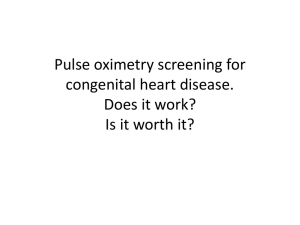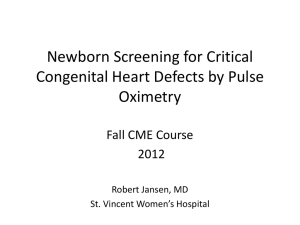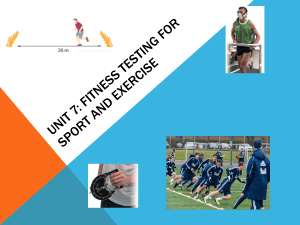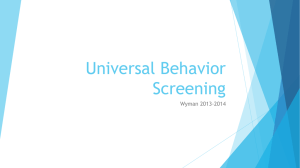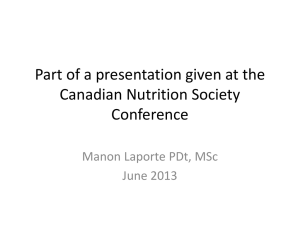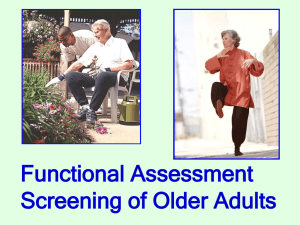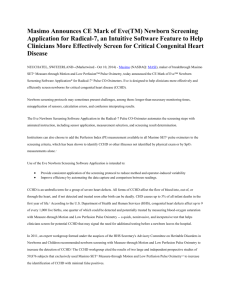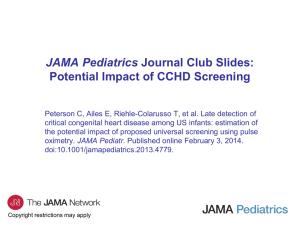(CCHD), Lazaros Kochilas, MD (6/15/2011)
advertisement
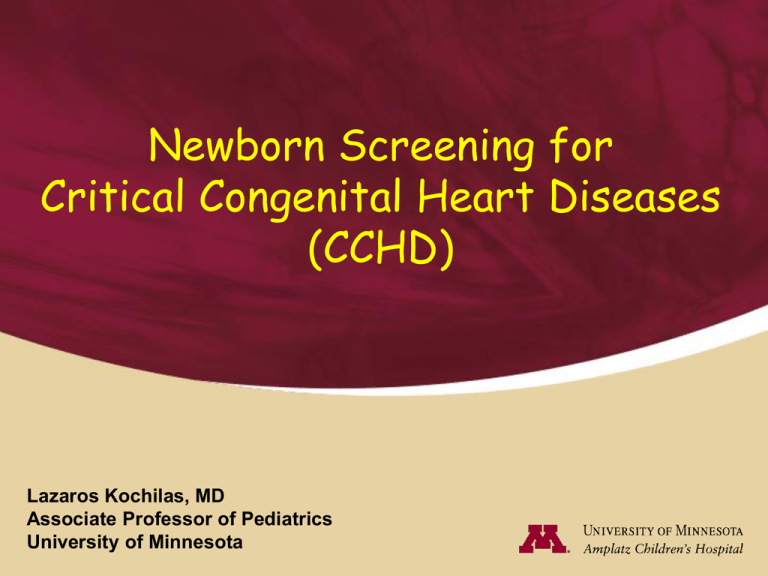
Newborn Screening for Critical Congenital Heart Diseases (CCHD) Lazaros Kochilas, MD Associate Professor of Pediatrics University of Minnesota Disclosures and Support Pediatric Grand Rounds Lazaros Kochilas, MD I will not discuss off label use and/or investigational use in my presentation and I have no conflicts of interest to disclose …however, I have an interest in the conflict of screening for CCHD! Advocates: Families with CHD Ped. Cardiologists Possible opponents: Delivery Hospitals Third party payers Neutral: Public Health analysts Learning objectives • Identify need for screening for CCHD in the nursery • Discuss evidence-based recommendations for newborn screening for CCHD • Describe efforts for screening implementation on state and national levels • Discuss barriers for screening implementation Criteria for using and appraising screening • Population: - sufficiently high incidence of screened condition - likely to be compliant • Condition: - significant mortality / morbidity - known natural history with detectable presymptomatic period - treatment makes a difference when introduced early • Test: - suitable (simple, safe, reliable, validated) - known distribution of values in diseased and non-diseased - acceptable validation process for (+) screens - widely available and acceptable • Treatment: - acceptable, available, effective, agreement on whom to treat • Program: - adequate staffing/facilities - program is acceptable and effective - acceptable cost - quality management / ongoing re-evaluation Selection Criteria for Newborn Screening Conceptual Framework Definition - Identifiable at birth - Condition characteristics Test characteristics – Treatment - Cost effectiveness Concepts in screening • All screening programs do harm; some do good as well • Criteria for appraising screening • Screening is a program not a test • Assess opportunity cost Wilson, J and Jungner, J: Principles and practice of screening for disease: WHO, 1968 Gray, MJ: New concepts in screening; BJ Gen Practice, 2004, 54, 292-298 Particular challenges • Limitations of randomized controlled studies • Limited evidence to assess benefit/risk ratio Disease Screening adverse effects + - - A B + C D • Need to calculate opportunity costs “Would you spend $$$ for screening for CHD?” vs. “If you had $$$ to spend for the field of CHD would you spend it for screening?” • Public pressure for increasing sensitivity of the testing • Challenge of definition Process for addition of new conditions to the uniform panel of newborn screening Nomination Form • Not adding to the NBS • Additional studies • Pilot study • Targeted screening • Add to NBS HRSA Administrative Review Evidence Review Group SACHDNC* Recommendations to the HHS Secretary *Secretary’s Advisory Committee on Heritable Disorders in Newborns and Children Implementation workgroup Timeline of pulse oximetry screen for CCHD Large European prospective studies (Norway, Sweden, UK, Germany, Switzerland) oximetry screen 1st clinical reports Larger prospective study In NY (Koppel) Request to AHA For recommendations Several European countries adopt pulse-ox screen as standard of care SACHDNC recommended adding pulse-ox screen AHA comment Evidence not sufficient Proposed bill in TN to mandate screening 2002 2005 AHA/AAP statement comment 2008 2011 Definition of the primary target: Critical CHD (CCHD) Requiring surgical, cath or pharmacologic intervention to avoid death or end-organ damage - Hypoplastic left heart syndrome (HLHS) - Pulmonary atresia -Tetralogy of Fallot (TOF) -Total anomalous pulmonary venous return (TAPVR) - Transposition of the great arteries (TGA) - Tricuspid atresia - Truncus arteriosus Current Uniform Screening Panel • 29 primary conditions -20 metabolic detected by MS (AA, FAO, OA) -3 Hg-pathies (S/S, S/β Thal, S/C) - 6 Others (BIOT, CAH, CF, CH, GALT, HEAR*) • 25 secondary targets -22 metabolic detected by MS (AA, FAO, OA) - 1 Hg-pathies variants - 6 Others (GAL-epimerase, GAL-kinase) * Only point-of-care type of screening Congenital Heart Diseases: The magnitude of the problem CHD: 5-10 / 1,000 live births 1.4 cyanotic CHD / 1,000 live births 2 critical CHD / 1,000 live births 25,000 cases of CHD/yr in US 25% of infantile deaths 31% of neonatal deaths All together 1.55 /1,000 live births Heron, M., et al. (2009). Deaths: Final data for 2006. National Vital Statistics Reports, 57(14). U.S. CDC and Prevention. http://www.cdc.gov/ncbddd/features/heartdefects-keyfindings2010.html Incidence of CHD Timing of death from CHD 50% of deaths from CHD occur in 1st year and 50% of infantile deaths occur in 1st month of life Boneva, R: Circulation. 2001;103:2376 Deaths from undiagnosed CHD in Wisconsin • 345,573 births (2002-2006) • 14 deaths during first 2 wks of life (1: 24,684) Benton, N and Hokanson,J: Missed Congenital Heart Disease in Neonates Congenital Heart Disease 2010; 5(3):292-296 Significant physiologic compromise from undiagnosed CHD • 490 patients with undiagnosed critical CHD (2000-2003) • 76 (15.5%) with significant physiologic compromise • 33 (6.7%) preventable • Incidence of potentially preventable 1:15,000-1:26,000 Schultz, A: Epidemiologic features of the presentation of critical CHD: implications for screening Pediatrics 2008; 121(4):751-757 Missed Critical Congenital Heart Diseases (CCHD) Hoffman, J. It is time for routine neonatal screening by pulse oximetry. Neonatology 2011;99:1-9 Types of frequently unrecognized CCHD Hoffman, J. It is time for routine neonatal screening by pulse oximetry. Neonatology 2011;99:1-9 Screening for CCHD - Fetal ultrasonography - Physical examination - Pulse oximetry Pulse oximetry as screening method - pulse oximetry measures the amount of O2Hgb in the arterial blood - based on differential absorption of O2Hgb and RHgb - coupled with ability to separate pulsatile from non-pulsatile components - non-invasive and painless - accurate with newer generation oximeters - “motion resistant” (SET) technology - fast (<2 min) and reliable - inexpensive - peripheral perfusion index (PPI) Distribution of O2 saturations in 24h newborns with newer generation pulse oximeters Newborns Critical CHD de-Wahl Grannelli, A: Acta Paediatrica 2005;94:1590 O2 saturation values in patients with CCHD de-Wahl Grannelli, A: Acta Paediatrica 2005;94:1590 Reliability in wide range of O2 saturations de-Wahl Grannelli, A: Acta Paediatrica 2005;94:1590 Peripheral perfusion index (PPI) for screening for critical left heart obstructive disease (LVOD) PPI < 0.7 in at least one limb suggesting of LVOD OR 23.8 [95% CI (6.4-88.7)] de-Wahl Grannelli, A: Acta Paediatrica 2007;96:1455 Studies examining pulse oximetry screening for CCHD - 13 large studies ( > 200,000 newborns ) - Overall test performance >24h: - Sensitivity 70% Specificity 99.9% - False Positive Rate 0.035% False Negative Rate 0.01% - Positive Predictive Value 47% Negative Predictive Value 99.9% - overall improved detection rate vs physical exam alone - improved outcomes? Mahle, W et al.: Role of Pulse Oximetry in Examining Newborns for Congenital Heart Disease A Scientific Statement From the AHA and AAP, Circulation 2009; 120:447-458 The Swedish prospective study (2004-2007) de-Wahl Grannelli, A: BMJ 2009; 338 W. Göteland Contemporary cohort Total 46,693 108,604 Screened 39,821 - 62 2 41 / 5 19 5 0 109 9 72 28 0 62% N/A 69 (0.17%) N/A 99.8% N/A 11 (0.03%) N/A CCHD Prenatal Dx Clinically / PE (only) Pulse Ox Undiagnosed Deaths Sensitivity False positives / FPR Specificity False negatives / FNR p-value 0.0025* 0.16* Screening in Minnesota: Region’s Hospital, Saint Paul • • • • Location: Urban (Twin Cities metropolitan area) Number of deliveries: 2,500/year Majority of pregnancies receive prenatal care No high risk pregnancies Newborn screen by pulse oximetry (Data provided by Larry Condon, MD) • Start of implementation: 2005 • Implemented as new standard of care – No consent • Timing: date of discharge (most cases≥ 24h) • Cut off for normal ≥ 95% • Location of probe: foot • Type of probe: reusable • No consent • No formal f/u procedure Screening Results Total patients 12,462 Total ECHOs 34 (0.27 %) Indications Murmur 22 Syndromes 7 IDM 2 Abnormal screens 3 (0.024%) CCHD 2 (0.016 %) False positives 1 False negatives 0 Practical considerations • asymptomatic newborns in well baby nursery ≥ 24h of age • newer generation pulse oximeters • motion resistant technology measuring functional O2 saturation • accuracy (±2% root mean square error) • both single use and reusable probes acceptable • two sites: right arm and a foot • cut-off for positive screen: < 95% and │O2Sats RA- F│> 3 points (3 times) • any value <90% is abnormal • cut-off values for areas in high altitude not defined • screening incorporated with nursery’s practice and other screening activities Screening Protocol in well baby nursery for asymptomatic newborns >24h or shortly before discharge check pulse ox in right arm and foot in room air 90-94% in both sites or arm-foot difference > 3 points Re-screen in 1h < 90% in either site Irrespective or difference POSITIVE SCREEN 90-94 % in both sites or arm-foot difference > 3 points ≥ 95% or higher in either site and arm – foot difference ≤ 3 points Re-screen in 1h PASSED TEST PCP notified (FURTHER ACTION) 90-94% in both sites or arm - foot difference >3 points POSITIVE SCREEN DISCHARGE Response suggestions for primary caretaker to failed pulse oximetry screening for Critical Congenital Heart Diseases (CCHD) Failed Pulse ox screening: one value equal or less than 90% OR three times <95% in both sites or absolute difference of >3 points 1. Confirm accuracy of reading 2. If <24h consider deferring discharge and repeat test at 24h or later; otherwise, follow same algorithm as in older infants 3. Perform additional clinical evaluation to assess for non-cardiac causes 4. Echocardiogram (in-center, transfer, telemedicine) Comparative cost of screening • CCHD: 8,000 cases per year in the US • Screen will cause additional 8,000 ECHOs per year • Cost: $9,000 (5.5-29K) per asymptomatic case diagnosed • Metabolic disorders: 6,400 cases per year in the US Cost of metabolic screen $110 / infant X 4 million/year = $440M / yr or $68,750 per patient diagnosed Expected annual activity for Minnesota • Minnesota birth rate: 70,000 • Distribution: 60% access to pediatric cardiology services (50% metro and 10% non-metro cities) • Expected positive screens: 46 • Expected false positive screens: 25 • Need for transfer: 18 Estimated financial cost • Nursing time: 5-10 min / screen $200K-$400K • Pulse oximeter equipment: $100K • Pulse oximeter supplies: $200K (reusable) $700K (single use) • Echocardiography cost: $70K-200K • Transport costs: $50K • Estimated total cost: $620K-$950K • Additional hospital time / hidden costs: ? * Annual Budget - Minnesota Department of Health (MDH) $500M / year ($7.5 M/ year on Newborn Screening) Barriers in implementation • Regulatory (informed consent, reusable probes) • Cost (equipment, supplies, personnel, transfers, days in hospital) • Health care personnel: nursing staff community practitioners echo technicians pediatric cardiologists • Equipment: pulse oximeters / ECHO machines & probes • Infrastructure & Accessibility • Medico-legal concern • Skepticism Summary • CCHD causes significant morbidity and mortality • Newborn screening for CCHD with pulse oximetry is promising • Physical examination still useful • Early diagnosis of CCHD may improve outcomes • Guidelines for implementation of screening have been defined • Future refinements likely Pulse Ox screening for CCHD is coming soon to a nursery close to you!
